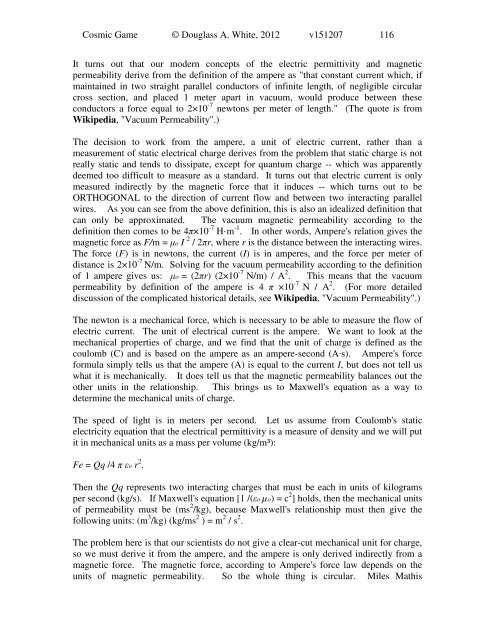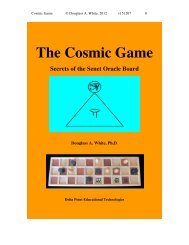Create successful ePaper yourself
Turn your PDF publications into a flip-book with our unique Google optimized e-Paper software.
<strong>Cosmic</strong> <strong>Game</strong> © Douglass A. White, 2012 v151207 116<br />
It turns out that our modern concepts of the electric permittivity and magnetic<br />
permeability derive from the definition of the ampere as "that constant current which, if<br />
maintained in two straight parallel conductors of infinite length, of negligible circular<br />
cross section, and placed 1 meter apart in vacuum, would produce between these<br />
conductors a force equal to 2×10 -7 newtons per meter of length." (<strong>The</strong> quote is from<br />
Wikipedia, "Vacuum Permeability".)<br />
<strong>The</strong> decision to work from the ampere, a unit of electric current, rather than a<br />
measurement of static electrical charge derives from the problem that static charge is not<br />
really static and tends to dissipate, except for quantum charge -- which was apparently<br />
deemed too difficult to measure as a standard. It turns out that electric current is only<br />
measured indirectly by the magnetic force that it induces -- which turns out to be<br />
ORTHOGONAL to the direction of current flow and between two interacting parallel<br />
wires. As you can see from the above definition, this is also an idealized definition that<br />
can only be approximated. <strong>The</strong> vacuum magnetic permeability according to the<br />
definition then comes to be 4π×10 -7 H·m -1 . In other words, Ampere's relation gives the<br />
magnetic force as F/m = μo I 2 / 2πr, where r is the distance between the interacting wires.<br />
<strong>The</strong> force (F) is in newtons, the current (I) is in amperes, and the force per meter of<br />
distance is 2×10 -7 N/m. Solving for the vacuum permeability according to the definition<br />
of 1 ampere gives us: μo = (2πr) (2×10 -7 N/m) / A 2 . This means that the vacuum<br />
permeability by definition of the ampere is 4 π ×10 -7 N / A 2 . (For more detailed<br />
discussion of the complicated historical details, see Wikipedia, "Vacuum Permeability".)<br />
<strong>The</strong> newton is a mechanical force, which is necessary to be able to measure the flow of<br />
electric current. <strong>The</strong> unit of electrical current is the ampere. We want to look at the<br />
mechanical properties of charge, and we find that the unit of charge is defined as the<br />
coulomb (C) and is based on the ampere as an ampere-second (A∙s). Ampere's force<br />
formula simply tells us that the ampere (A) is equal to the current I, but does not tell us<br />
what it is mechanically. It does tell us that the magnetic permeability balances out the<br />
other units in the relationship. This brings us to Maxwell's equation as a way to<br />
determine the mechanical units of charge.<br />
<strong>The</strong> speed of light is in meters per second. Let us assume from Coulomb's static<br />
electricity equation that the electrical permittivity is a measure of density and we will put<br />
it in mechanical units as a mass per volume (kg/m³):<br />
Fe = Qq /4 π εo r 2 .<br />
<strong>The</strong>n the Qq represents two interacting charges that must be each in units of kilograms<br />
per second (kg/s). If Maxwell's equation [1 /(εo µo) = c 2 ] holds, then the mechanical units<br />
of permeability must be (ms 2 /kg), because Maxwell's relationship must then give the<br />
following units: (m 3 /kg) (kg/ms 2 ) = m 2 / s 2 .<br />
<strong>The</strong> problem here is that our scientists do not give a clear-cut mechanical unit for charge,<br />
so we must derive it from the ampere, and the ampere is only derived indirectly from a<br />
magnetic force. <strong>The</strong> magnetic force, according to Ampere's force law depends on the<br />
units of magnetic permeability. So the whole thing is circular. Miles Mathis





